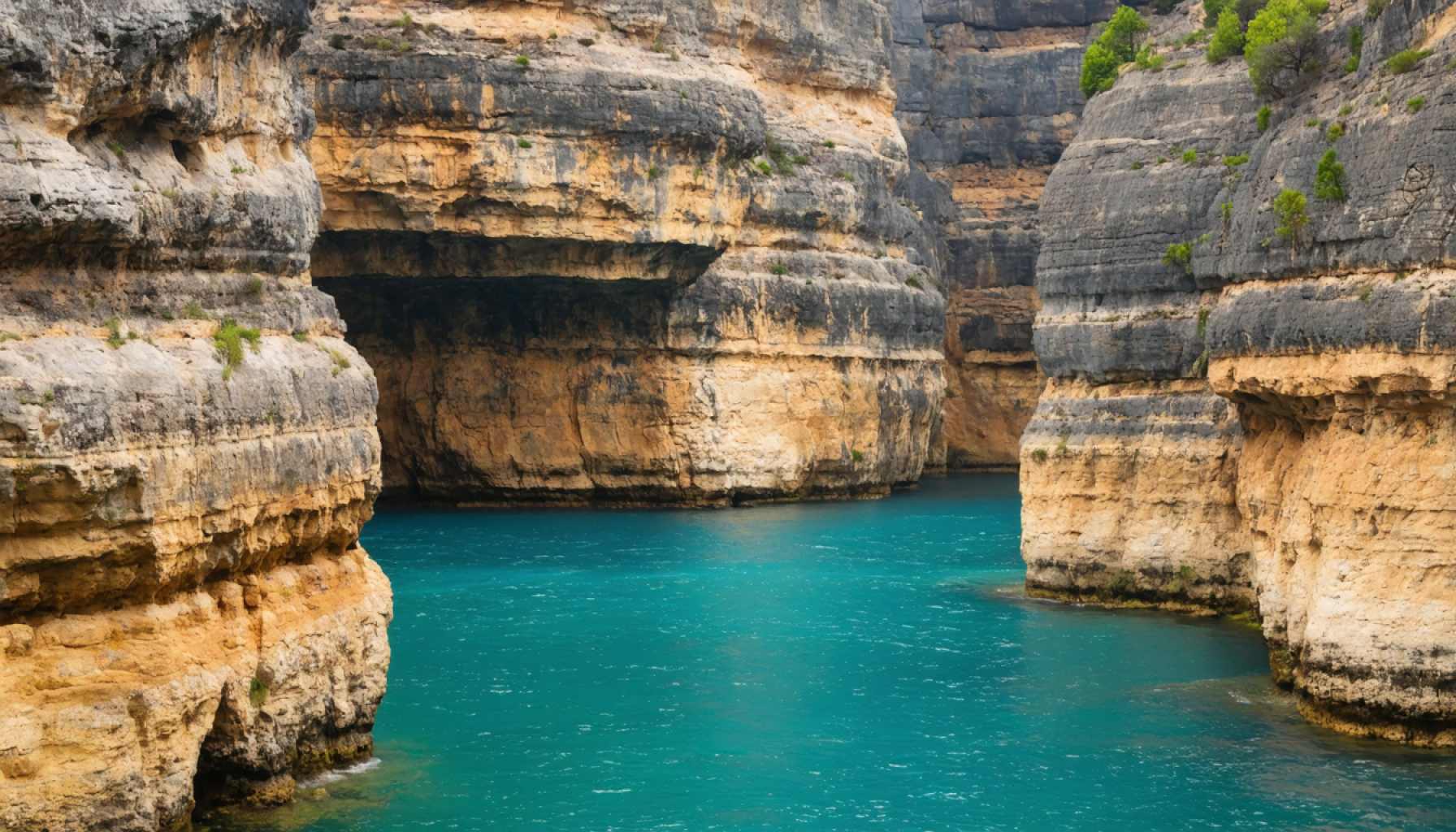
- Spain harbors remarkable natural wonders that offer unique adventures and experiences beyond its cultural and historical highlights.
- The Cueva de Valporquero in León features impressive karst formations and an underground river suitable for spelunking, showcasing geological beauty.
- The Río Inglares in Bergantzu, Basque Country, presents a picturesque scene of lush greenery and cascades, accessible by reservation only to protect its delicate environment.
- Roques de García in Tenerife provides stunning volcanic formations like ‘Roque Cinchado’, blending vibrant colors and panoramic views.
- Baños de Zújar in Granada is renowned for its soothing 38°C thermal waters set amidst picturesque limestone crags, offering relaxation and historical intrigue.
- The Illes Columbretes, volcanic islands off Spain’s eastern coast, support biodiversity with Eleonora’s falcons and coral-rich diving spots.
- Each location reveals Spain’s natural beauty, inviting exploration of its landscapes shaped by time and resilient against change.
Picture a land where ancient secrets whisper through vast caves, where cascading waters sway serenely beneath forest canopies, and where volcanic formations stand like timeless sentinels against a blue horizon. Spain, a country often celebrated for its vibrant culture and storied past, harbors untamed natural wonders that beckon the curious explorer.
Cueva de Valporquero: A Subterranean Marvel
Nestled in the lush landscapes of León, the Cueva de Valporquero unfolds like a page from a geological diary. Though a mere million years old, it stands as a titan among Iberian karst formations. An adventure unfurls across its seven expansive galleries adorned with vibrant stalactites and stalagmites. The adventurous can delve deeper, following an underground river perfect for spelunking. Every step reveals formations like ‘Las Gemelas’ and the awe-inspiring ‘Gran Rotonda,’ whose 20-meter-high natural dome resonates with the booming clamor of its cascading waters.
Bergantzu’s Watery Tapestry
In the heart of the Basque Country, the Río Inglares weaves its aquatic tapestry through Bergantzu. The gentle murmur of water threads a circular path of lush greenery and hidden cascades, demanding a reservation due to its fragile beauty. The star, Cascada de las Herrerías, spills gracefully amid a chorus of swaying trees, crafting a scene fit for a filmmaker’s lens. Following the path of an ancient hydroelectric canal, walkers find themselves ensnared in the magic of tunnels and narrow trails, all framed by the mountains’ embrace.
Roques de García: Stone Guardians of Tenerife
In the shadow of Mount Teide, the Roques de García rise with intriguing mystery. These stately volcanic formations, including the renowned ‘Roque Cinchado,’ display a palette of ochre, copper, and deep red hues. Their shapes, enigmatic and storied, have long puzzled geologists. Perched at 2,100 meters high, these ‘Stone Trees’ invite wonder from every angle, particularly the panoramic sweep from the Ruleta viewpoint, capturing a celestial landscape where rock and sky merge.
Thermal Tranquility at Baños de Zújar
Granada’s Baños de Zújar, steeped in Roman history, offers warmth not just from its famed 38°C mineral-rich waters but also from the embrace of rolling pine-clad hills. Amidst the Geoparque de Granada, these thermal baths tell tales of monastic care and resilience, surviving submersion to provide revitalization once more. The surrounding limestone crags bear witness to the Earth’s inner warmth spilling forth, inviting relaxation within its soothing currents.
Illes Columbretes: An Untouched Marine Sanctuary
Journey 45 kilometers off Spain’s eastern coastline to the Illes Columbretes, where sea and rock coexist in ecological harmony. These volcanic isles, named by Romans who vanquished their serpentine residents, present a tableau of biodiversity. Here, Eleonora’s falcons patrol the skies while the sea’s depths, cloaked in rare red coral and kelp forest, offer a controlled paradise for divers. Each island, from the crater-ridden l’Illa Grossa to the solitary Carallot pinnacle, whispers of nature’s indomitable creativity.
Each of these mystical corners of Spain reveals a world not just of visual splendor but of stories written in stone and water. They invite us to seek beyond the postcards and relish the world as changed by time yet untouched by its rush. Venture into this realm of natural wonders, for in doing so, you embrace the extraordinary narratives etched into the Earth’s very fabric.
Explore Spain’s Enchanting Landscapes: Beyond the Beaten Path
Discovering the Depths: Facts and Insights
While the source article paints an evocative picture of Spain’s natural wonders, let’s delve deeper into facts and insights that further showcase the significance and allure of these locations.
Cueva de Valporquero: Geological and Ecotourism Significance
– Geological Formation: The Cueva de Valporquero is an essential part of the Cantabrian Mountain range, offering valuable insights into karst development in a limestone environment. This formation is crucial for geological studies concerning the cave’s speleothems, which provide climate data extending back millennia.
– Visitor Experience: The cave is open to visitors year-round, but the optimal visiting months are from spring to early autumn. Guided tours are available, which typically last around 1.5 to 2 hours. It is recommended to wear appropriate footwear and clothing due to the cave’s damp conditions.
Bergantzu’s Watery Tapestry: A Hidden Gem
– Biodiversity and Conservation: The area around Río Inglares, particularly the Cascada de las Herrerías, is home to several endemic species of plants and insects, making it a significant ecological niche. Conservation efforts focus on maintaining its natural beauty and mitigating human impact, hence the reservation requirement for visitors.
– Hiking Tips: The trail around Bergantzu is mild, suitable for most fitness levels, and well-marked. Hikers should be prepared with snacks, water, and possibly trekking poles for stability.
Roques de García: Geological Wonders and Photography
– Visiting Plan: The Roques de García are best viewed at sunset when the light enhances their vivid colors. This area is also part of the Teide National Park, which requires bookings during peak seasons.
– Photography Tips: These volcanic formations are a photographer’s dream. For dramatic landscape shots, use a wide-angle lens and try to capture the shifting shadows during sunset or sunrise.
Thermal Tranquility at Baños de Zújar: Health Benefits
– Thermal Springs Benefits: The mineral-rich waters at Baños de Zújar are known for their therapeutic benefits, which include improving circulation, easing muscle pain, and providing stress relief, attributed to high levels of sulfates and magnesium.
– Real-World Use Case: Combine a visit to the thermal baths with a hike in the Geoparque de Granada for a full day of wellness and exploration.
Illes Columbretes: Marine Life and Diving Experience
– Marine Biodiversity: The Illes Columbretes archipelago is a haven for marine biologists and divers alike. It contains ecosystems untouched by commercial fishing, allowing species like red coral and Mediterranean fish to thrive.
– Diving Tips: Only a limited number of permits are allowed per day for diving to protect the delicate marine environment, so it’s essential to book in advance. Diving here is recommended for experienced divers due to the currents and depth.
Key Questions Answered and Recommendations
Is it safe to visit these sites year-round?
– Safety Considerations: Each location has different peak seasons and conditions. Always check local advice, weather conditions, and any required reservations or permits before visiting.
What are the best ways to reach these remote sites?
– Transportation Tips: Most sites are accessible by car. It’s advisable to rent a vehicle for convenience, particularly if planning to visit remote or multiple locations.
Actionable Travel Tips:
1. Plan Ahead: Due to the popularity and ecological sensitivity of these sites, booking in advance is often necessary.
2. Respect the Environment: Stick to marked paths, avoid littering, and engage responsibly with the local wildlife and landscapes.
3. Cultural Context: Embrace local customs and learn a few Spanish phrases to enrich your travel experience.
For more insights on traveling in Spain and its cultural and natural wonders, visit the official website of Spain Tourism.



